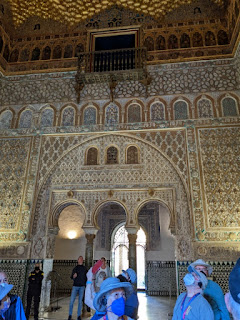Our ship actually sailed up a river to the heart of Seville while we slept. After we docked, it didn't look like either bridge was a type that could open, but they must have, because a day later, a ship with twice as many cabins and several more levels docked next to us. I really wanted to watch our departure, but since we were disembarking the day after we left Seville, there were mandatory meetings while the most curious part was happening.
Seville was captured by the Moors in the 700s and not wrested away from them until the 1200s. Seville was the primary origin of the early exploration of the Americas, and Columbus sailed from here. Our ship was docked near the remnants of the 1929 World's Fair here and we drove past a long line of still standing pavilions primarily from Spain's South American colonies.
 |
| Part of the Park of Maria Lusia |
 |
| Replica of one of the old exploration ships |
 |
| Torre del Oro -- an old watchtower. |
On the way to the Alcazar Palace, we walked past the Seville Cathedral, the third largest in Europe, but skipped the option to see it because we have see seen so many.
 |
| Seville Cathedral |
 |
| Mounted police |
 |
| Seville Cathedral above and below |
 |
| Plaza del Triunto, next to the Cathedral |
The Palace was started by the Moors, but expanded by Christians after the re-conquest. We are posting a lot of photos from the Alcazar because it was huge and impressive. Many times, the ceilings were as impressive as the walls. I sometimes used selfie mode pointed toward the ceiling to take a photo without having to contort myself. |
The next 4 photos are from a room
celebrating Spanish explorers. |
 |
| One of Columbus' ships |
 |
| A crest commemorating Columbus |
Then we walked through the Jewish quarter, where Jews lived until the Spanish Inquistion when they were forced to convert, were tortured, or finally expelled from the county in 1492.There were some interesting nut and chocolate shops as we exited and then we went shopping for a leather jacket and barely made it back to the ship in time for lunch. After dinner, there was a subset of a professional flamenco group who performed for us. Flamenco is not a set dance, but a set of moves inspired in the moment by the music and the reactiveness of the crowd. I guess they liked us because their work was impressive and the male dancer commented to Marcel later that dancing for us was like being in a good kind of a trance (maybe like a whirling dervish). Sometimes, the dancers took turns performing and other times they danced together. At times they looked quite fierce.



























































No comments:
Post a Comment